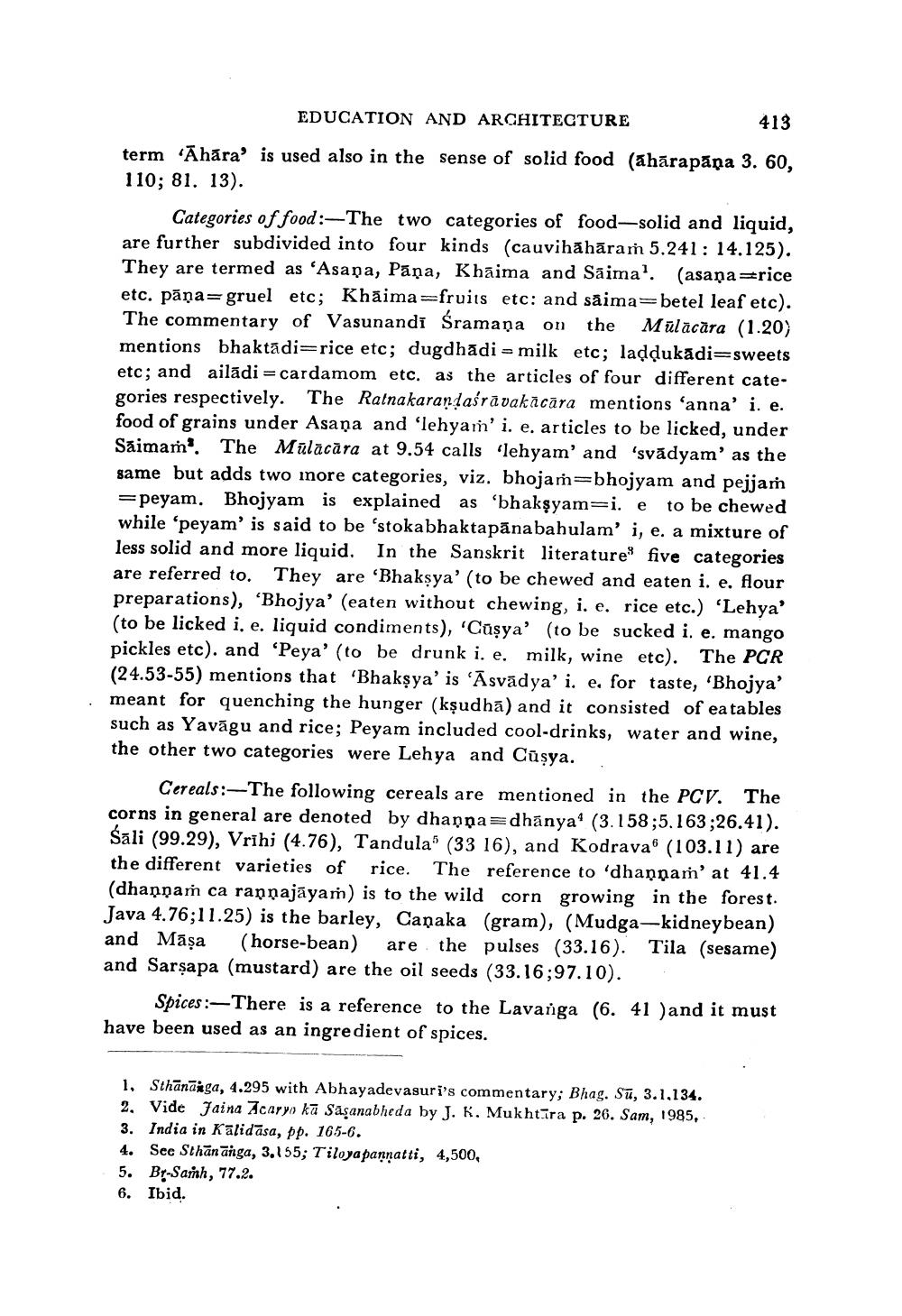________________
EDUCATION AND ARCHITECTURE
413
term "Āhāra' is used also in the sense of solid food (ahārapāņa 3. 60, 110; 81. 13).
Categories of food :—The two categories of food-solid and liquid, are further subdivided into four kinds (cauvihāhāram 5.241: 14.125). They are termed as 'Asaņa, Pāņa, Khāima and Saima'. (asana=rice etc. pāņa=gruel etc; Khaima=fruits etc: and saima=betel leaf etc). The commentary of Vasunandi Śramaņa on the Mülācāra (1.20) mentions bhaktādi=rice etc; dugdhādi = milk etc; laddukadi=sweets etc; and ailādi=cardamom etc. as the articles of four different categories respectively. The Ratnakarandaśrāvakācāra mentions 'anna' i. e. food of grains under Asaņa and 'lehyam' i. e. articles to be licked, under Sãimam! The Mülācāra at 9.54 calls 'lehyam' and 'svădyam' as the same but adds two inore categories, viz. bhojaṁ=bhojyam and pejjam =peyam, Bhojyam is explained as 'bhakşyam=i. e to be chewed while 'peyam' is said to be 'stokabhaktapānabahulam' i, e, a mixture of less solid and more liquid. In the Sanskrit literatures five categories are referred to. They are 'Bhakşya' (to be chewed and eaten i. e. flour preparations), 'Bhojya' (eaten without chewing, i. e. rice etc.) 'Lehya' (to be licked i. e. liquid condiments), 'Cūşya' (to be sucked i. e. mango pickles etc). and 'Peya' (to be drunk i. e. milk, wine etc). The PCR (24.53-55) mentions that 'Bhakşya' is 'Āsvādya' i. e. for taste, 'Bhojya' meant for quenching the hunger (kşudhā) and it consisted of eatables such as Yavāgu and rice; Peyam included cool-drinks, water and wine, the other two categories were Lehya and Cūşya.
Cereals:-The following cereals are mentioned in the PCV. The corns in general are denoted by dhanna=dhanya? (3.158;5.163;26.41). Sali (99.29), Vrihi (4.76), Tandula" (33 16), and Kodrava (103.11) the different varieties of rice. The reference to 'dhannam'at 41.4 (dhaņņam ca rannajāyam) is to the wild corn growing in the forest. Java 4.76;11.25) is the barley, Canaka (gram), (Mudga-kidneybean) and Māsa (horse-bean) are the pulses (33.16). Tila (sesame) and Sarsapa (mustard) are the oil seeds (33.16;97.10).
Spices :— There is a reference to the Lavanga (6. 41 )and it must have been used as an ingredient of spices.
1, Sthānāäga, 4.295 with Abhayadevaguri's commentary; Bhag. Sü, 3.1.134. 2. Vide Jaina 7caryo ka Saşanabheda by J. K. Mukhtira p. 26. Sam, 1985, 3. India in Kalidasa, pp. 165-6. 4. See Sthānanga, 3,155; Tiloya pannatti, 4,500, 5. Bt-Sanh, 77.2. 6. Ibid.




